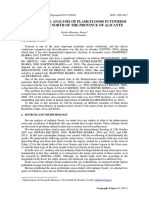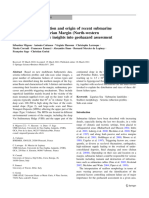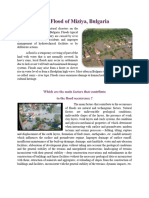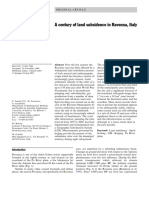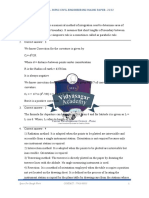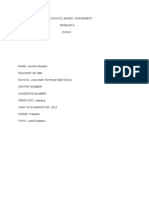Professional Documents
Culture Documents
Alluvions and Flooding of Waters in Uvira (DR Congo)
Original Title
Copyright
Available Formats
Share this document
Did you find this document useful?
Is this content inappropriate?
Report this DocumentCopyright:
Available Formats
Alluvions and Flooding of Waters in Uvira (DR Congo)
Copyright:
Available Formats
Volume 6, Issue 3, March – 2021 International Journal of Innovative Science and Research Technology
ISSN No:-2456-2165
Alluvions and Flooding of Waters in Uvira
(Dr Congo)
MWENYEMALI BANAMWEZI Dieudonné1, KAHINDO NDJUNGU Joseph 1, FUNTA KYANDA Clément1,
TOMOMBWA KUMBUSA Patient1 and AMISI MANALA Christian2
1.
Hydrology department, Uvira hydrobiology Research Center, CRH-Uvira BP 73 Uvira, DR Congo.
2.
Department of Fisheries Socioeconomics, Uvira, Research Center CRH-Uvira BP 73 Uvira
Abstract:- The present work, carried out during the environment of populations living in periodically flooded
years 2000 to 2020 in rainy seasons, aims to describe the regions (Martin A et al. 2016).
impact of excessively abundant alluvium on the flooding
of rivers in Uvira. From direct observation of the facts The city of Uvira is facing the problem of flooding of
in the field, we have shown that the raising of the beds rivers, Lake Tanganyika and Nyangara lagoon. Flooding of
of the rivers and the obstruction of the outlets of the rivers in the city of Uvira is old and recurrent and has
water of the rivers by too abundant alluvium, are two already been investigated: (Mwenyemali B. et al. 2014;
factors. Which condition the flooding of rivers observed Mwenyemali et al 2020). This work focuses on the damage
in the city of Uvira for several years? caused by flooding and the human influence in this
damage.
We have proposed reforestation, anti-erosion
cultivation practices and systems, the prohibition of In addition, the formation of "debris flows", "flood-
untimely bush fires for farmers in all watersheds of alluvial" zones as well as the straying of watercourses and
watercourses in order to limit erosion based on intense the digging of ravines lead to the destruction of dwellings,
alluvial deposits that cause these river floods. drainage channels and roads of Uvira (Ilunga L.2006).
Keywords:- Alluvium, Floods, Watercourses, Uvira. Twenty-five Mitumba Massif rivers flow through the
city of Uvira. In certain rainy seasons, during torrential
I. INTRODUCTION crises, most of these rivers deposit excessively abundant
alluvium in their lower sections, the region of the piedmont
The submersion of land usually exposed by plains and those of the base level. Can this excessively
overflowing lakes or rivers is undoubtedly the major risk abundant alluvium explain the flooding of rivers in Uvira?
on all continents. The danger of human and economic loss The aim of this work is to describe and explain the impact
is accentuated by the construction of numerous installations of too much alluvium on the flooding of rivers in Uvira and
in flood-prone areas (Touchard L. 2003). to make concrete proposals on how to slow these
phenomena.
Rain and other factors cause flooding, the water of
which degrades the physical environment and the living
IJISRT21MAR657 www.ijisrt.com 1328
Volume 6, Issue 3, March – 2021 International Journal of Innovative Science and Research Technology
ISSN No:-2456-2165
II. MATERIALS AND METHOD
a. Map of the study environment.
Fig.1 Rivers crossing the city of Uvira.
These streams (7 permanent and 18 temporary) from The data were collected in the lower reaches of the
Mitumba massifs cross the city of Uvira before emptying rivers, in their riparian zones, affected by "flooding-
into Lake Tanganyika or the marshes and lagoon located to alluvial" as well as in the regions of the middle and upper
the north of the lake. reaches of the watersheds. Data collection was carried out
during the period from 2000 to 2020 during the rainy
The city of Uvira, located at the extreme northeast of seasons, especially after floods, from December to May.
Lake Tanganyika, is bounded on the north by the Kawizi
river, on the south by the Sangeza river, on the west by the b. Direct observation of the facts in the field, through
Mitumba massifs and on the east by the Lake Tanganyika visits and excursions, is the general basic method.
and the Ruzizi river.
Observations focused on: the flooding phenomenon in
The city of Uvira comprises two geological and order to identify its direct causes and understand its
geomorphological groups: mechanisms, deposited alluvium, "flood-alluvial" zones,
Mitumba mountains (2000 to 3000 m) to the west, the erosive phenomenon as well as the damage caused by
formed by Precambrian terrain: quartzites and mica flooding.
schists. There are also amphibolites, gneisses,
pegmatites as well as veins of white quartz. These rocks These observations were accompanied by:
form dipping layers of 40 ° to 90 ° (Weiss G. 1959). Taking geographic coordinates, using a GPS (Global
The plain (774 to 900) in the east, represented by the Positioning system) to locate the observed facts.
fluvio-lacustrine detrital formations of the Quaternary. Measurements of block diameters, thickness and extent
of alluvial deposits, using a decameter and a metal lath;
The population of the city of Uvira is concentrated in collecting sand samples, using a shovel. This allowed us
this plain (3º17'03'S '; 3º26'27''S and 29º7'E; 29º12'E), to determine the morphometry and the granulometry of
crossed by the lower reaches of the rivers. The city is the alluvium.
crossed from north to south by the RN5. Taking pictures of the observed facts, using a digital
camera, in order to compensate for direct observation.
The hydrological survey, among residents and
eyewitnesses, to inquire about past floods.
IJISRT21MAR657 www.ijisrt.com 1329
Volume 6, Issue 3, March – 2021 International Journal of Innovative Science and Research Technology
ISSN No:-2456-2165
III. RESULTS These blocks and pebbles were deposited during a
flood in April 2020. This torrent is famous for its disaster
The results obtained are presented in figures (2, 3, 4, of February 2002, the results of which were heavy: more
5, 6 and 7). than 50 dead, and a lot of material damage (houses
destroyed, RN5 barred by big blocks for two weeks: no
a. Too abundant alluvium raises the bed, the rivers access to the lake port of Kalundu.
overflow and spread.
Fig. 2 Torrent Nyarumanga (03 ° 23'99''S; 29 ° 08'12''E. Fig.4. Rivière Kavimvira (3°32’47’’S; 29°15'89, 9’’E.
860m) 788m)
Torrent known for its recurrent flooding. Torrential Intense accumulation of sand and gravel, upstream
alluvium still made up of blocks, pebbles and clayey mud. and downstream of the bridge, during the flood of
This alluvium was deposited during the flood of 04/17/2020. Here, the human habitat and a small market are
23/04/2020, which had the effects: 8 houses buried by located upstream of the bridge on the left bank. Before the
alluvium and 10 destroyed houses. Spreading of alluvium flood, they were at a higher level than the minor bed. After
In May 2018, this torrent caused material and human losses raising the bed, they were flooded and flooded with
including 4 deaths, children from the same family who sediment. Subsequently, the market was completely buried
slept in their beds. and the habitat is at a much lower level in bed because of
sedimentation. Likewise, the bridge, which was 4.50m
above the water, is already at 2.40m. Spreading of
alluvium.
Fig. 3 Torrent Kamongola (03 ° 25'48''S, 29 ° 07'51''E.
796m) Fig.5 Rivière Mulongwe (03°20'18, 7’’S; 29°09'30''E.
787m).
IJISRT21MAR657 www.ijisrt.com 1330
Volume 6, Issue 3, March – 2021 International Journal of Innovative Science and Research Technology
ISSN No:-2456-2165
The river raised its bed by sandy-gravelly alluvium and the gullying of a citrus plantation located more towards
during the flood of 04/17/2020, and it is already above the the right bank downstream . Spreading alluvium.
level of the habitat. We observe the spreading of alluvium.
IV. DISCUSSION
b. Too abundant alluvium clogs fluvial or torrential
water flow nozzles, overflow and spreading. These alluviums are characterized by two size
classes: boulders and sands, varying from one stream to
another and within the same stream from one point to
another :
Blocks: The accumulations of blocks, often associated
with pebbles, dominate in certain streams above (fig. 2
and 3) and others: Ruzozi, Sangeza, Nakagonjwa,…
These are quartzite blocks of decimetric size to metric:
the largest of 6.90m thick was observed in the
Mulongwe river, at the foot of the mountains where the
latter empties into the plain. These blocks reflect the
strong energies of the current of these rivers. The
quantity and size of the elements transported is a direct
result of the speed of the current. This depends on two
main factors: the slope of the land and the volume of
moving water (Laverdiere J.W. et al. 1959).
Sands: Characterize other rivers, including fig. 4 and 5
and others: Kalimabenge, Kaala, Nyangwi,...
Sometimes gravelly sand is observed. Particle size
analysis shows that these are sands with various grains,
mainly coarse sand (500µ-1mm) with a large percentage
of medium sand (250µ-500µ) and very coarse sands
Fig.6 Torrent Kaala (03°12'45, 7’’S; 29°09'34, 4’’E.
(1mm-2mm).
806,7m).
This predominance of the sandy fraction in these
Torrent with recurrent floods. In April 2000 the
alluvium (sands, gravel, pebbles and boulders) blocked the rivers shows that mechanical disintegration outweighs
chemical decomposition in watersheds (Gryzbowski K.
nozzle, below the RN5, and forced the water to overflow
1984, Tricart J. 1968).
over the RN5. We observe the degradation of the RN5 and
the houses located downstream of the bridge.
This abundance of alluvium including boulders and
sands, associated with pebbles and gravel, can be explained
by the very active erosion observed in the watersheds of
these rivers. Indeed, it is very intense erosion, (Degree 4),
according to the classification system of fluvial and
torrential erosion developed by the US Forest Service
(Sheng TC, 1993).
This erosion is characterized by:
landslides: we have counted more than 130, most of
which are located in the reception basins of these rivers:
45 in the Kavimvira watershed, 46 in Mulongwe, 1 in
Nyarumanga, 3 in Kabindula , 32 in Kalimabenge, 8 in
Kamongola, 3 in Ruzozi ...
Intense gullying: many gullies, most of which are
temporarily drained.
bank erosion in the beds of all rivers:
This erosion in these watersheds is under the
combined action of abundant rains (<1000 mm in the plain
and> 1200mm in the mountains), linked to climate change,
Fig.7 Torrent Rutemba (03°18'9, 1"S, 29°9'36, 4"E. 814m) steep slopes (of more than 50 °.) And characterized human
activities. by inadequate cultivation methods on steep
Torrent with recurrent floods. After obstruction of the slopes, deforestation, untimely fires for the farmer and
nozzle below the RN5, by alluvium in April 2000, the stockbreeder, pasture,…. The steepness of the slopes, the
water overflowed and resulted in the erosion of the RN5 weakness of the vegetation cause the rainwater to run off
and concentrate very quickly, gullying the sides of the
IJISRT21MAR657 www.ijisrt.com 1331
Volume 6, Issue 3, March – 2021 International Journal of Innovative Science and Research Technology
ISSN No:-2456-2165
slopes and causing a significant load of mud, pebbles and From all the above, it emerges that the too abundant
large boulders (Georges P.1974 , Taillefer et al. 1965). alluvium, the manifestation of which is the raising of the
beds and the obstruction of the outlets constitute a problem
It should be noted that, since 2005, only the based on flooding in the city of Uvira. We must therefore
Kakungwe torrent no longer experiences this problem of fight against this abundance of alluvium in order to smother
intense alluvial deposits. This situation is linked to the fact the floods caused by material damage and sometimes
that for several years its watershed has not been exposed to human losses.
agricultural activities as in the past.
Indeed, efforts to fight against floods have been
Indeed, the rivers, very laden with alluvium in rainy undertaken for a long time but in vain due to the intense
seasons, raise their beds and flow to a higher level than the alluvial deposits. These efforts have included dredging
surrounding regions: the water overflows and inundates the some streams and building dikes along others. This was the
regions occupied by human habitat (2, 3 , 4 and 5). This case with the dredging of the Kavimvira and Mulongwe
overflow of water is accompanied by the mobility of the rivers during 2008 and 2020. In addition, the dikes erected
bed and consequently the destruction of homes (Ilunga L. along the Nyarumanga torrents (in 1997 and 2016), by the
2006, Mwenyemali et al. 2020). Caritas of the Diocese of Uvira , Kaala (1919) were buried
This migration or wandering of the bed often results and destroyed by abundant alluvium.
in the displacement of the mouths of certain major rivers,
including Kalimabenge, Mulongwe and Kavimvira. V. CONCLUSION
On the other hand, the obstruction of the outlets The raising of the beds of the rivers and the
forces the water to flow over the road and move either in obstruction of the river flow nozzles are two determining
all possible directions or to wander the channel. Flooding factors which condition the flooding of these rivers and the
depends not only on the flow but also on the obstacles to consequent damage in the city of Uvira.
the flow (Touchart L. op.cit.). Thus, the alluvium clogs the
evacuation nozzles, overflows on the roads and will To deal with this problem of too abundant alluvium
partially bury the habitat located downstream up to the which conditions river floods in the city of Uvira, we have
height of the windows about 1.5m (Ilunga L. op.cit.). In proposed the following:
1988, alluvium from the Kalimabenge congested upstream The reforestation of all the watersheds of the rivers
of the bridge and obstructed the underside of this bridge on crossing the city, especially in the reception basins
the RN5. After the water overflowed, this flood had caused where most landslides are located.
a great deal of material and human damage. The sensitization of the population on anti-erosion
agricultural practices and systems as well as the
These floods linked to the obstruction of the fluvial prohibition of bush fires in the watersheds of rivers.
and torrential flow nozzles are observed in a recurrent Widening of fluvial and torrential water outlets.
manner in most of the rivers of Uvira (fig. 5 and 6), Karigo, The relocation of the riparian human population living
Kagenge, Kibondwe. in areas at high risk of river flooding.
These floods linked to the raising of the bed and the Geological, geomorphological, hydrological and
obstruction of the nozzles by alluvium have the effect of climatic studies of the watersheds of these rivers must be
flooding and spreading alluvium: it is "flooding-alluvial" carried out with a view to the protection, improvement and
which is accompanied by the destruction of the soil. rehabilitation of these basins located in mountainous areas.
dwellings.
REFERENCES
This spreading sometimes extends over large areas
and the deposits are, in several places, more than 2 m thick [1]. Fehri N. 2014 The Aggravation of the risk of flooding
following observations made in certain neighborhoods in Tunisia: elements for reflection.
during the April 2020 floods. [2]. Gryzbowski K 1984. The preliminary results of the
granulometric analysis of the current sands of Uvira,
These sediments mobilized during floods Cahier du Ceruki, New series no 12.
accumulate especially in areas where the slope decreases as [3]. Georges P. 1974. Dictionary of Geography, PUF
well as in flared sectors (Fehri 2014) .These alluvial Boulevard Saint-Germain, Paris.
spreading phenomenon undoubtedly results in the [4]. Ilunga L. 2006. Study of major erosion sites in Uvira
undeniable modification of the morphological landscape (DR. Congo) Géo-Eco-Trop 30.2.1-12.
(Lamar, 2009). ). [5]. Lahmar L. 2009. Floods and their impact on the
morphological landscape: the case in the Jendouba-
Karigo, Kagenge, Kibondwe, Konda, Nabatumba, Bon Salem plain (North-West Tunisia).
Nakironge, Nyange and Nalungwe. [6]. Laverdière J.W., 1959, Initiation à la Géologie. 7th
edition, 23rd thousand Montreal and Paris.
IJISRT21MAR657 www.ijisrt.com 1332
Volume 6, Issue 3, March – 2021 International Journal of Innovative Science and Research Technology
ISSN No:-2456-2165
[7]. Martin A. et al. 2006, Flood in Benin: socio-
economic impacts on lake populations.
[8]. Mwenyemali B. et al. 2014. Impact of the
Topography on the natural disasters observed in the
city of Uvira, northwest of Lake Tanganyika, Cahiers
du Ceruki, New series no16.
[9]. Mwenyemali B. et al. 2020, Effects of Bank Escapes
and Floods in the Kavimvira River side
Neighborhoods. International Journal of Innovative
Science and Research Technology, volume 5 January.
[10]. Neuvy G. 1991. Man and water in the tropics.
Masson, Paris, Milan, Barcelona, Bonn
[11]. Sheng TC. 1993. Practical guide for watershed
management. Studies and planning. FAO
conservation notebook 13/6.
[12]. Taillefer F. et al. 1962. General physical and human
geography, second class 4th edition Armand Colin
103, Boulevard Saint Michel.
[13]. Touchard L. 2003. Hydrology. Seas, Rivers and
Lakes, Armand Colin / VUEF.
[14]. Tricart J. 1968. Précis de Géomorphologie Tome 1.
Géomorphologie Paris Ve.
[15]. WEISS G., 1959. Country of Uvira. Regional
geographic studies on the western edge of Lake
Tanganyika. Brussels, J. Duculot.
IJISRT21MAR657 www.ijisrt.com 1333
You might also like
- Massive Flooding Causes in Oriental MindoroDocument29 pagesMassive Flooding Causes in Oriental MindoroBJ GaiteraNo ratings yet
- Geographical Analysis of Flash Floods in Tourism AreasDocument4 pagesGeographical Analysis of Flash Floods in Tourism AreasIryna SikoraNo ratings yet
- 1-The Effects of Urbanization On Grouad-WaterDocument7 pages1-The Effects of Urbanization On Grouad-WaterMuhannad RasemNo ratings yet
- Mapping of Areas at Risk of Flooding in The Driouch City Kert Basin North East of MoroccoDocument11 pagesMapping of Areas at Risk of Flooding in The Driouch City Kert Basin North East of MoroccoInternational Journal of Innovative Science and Research TechnologyNo ratings yet
- The Long Term Fate and Environmental Sig PDFDocument17 pagesThe Long Term Fate and Environmental Sig PDFMihai BotizNo ratings yet
- Investigation of Siltation in Dumaguil River: Oertitle PageDocument18 pagesInvestigation of Siltation in Dumaguil River: Oertitle PageYusuf GeronaNo ratings yet
- Impacts of The In-Stream Aggregate Mining in The Alluvial Fans of NW ArgentinaDocument19 pagesImpacts of The In-Stream Aggregate Mining in The Alluvial Fans of NW ArgentinaMaria Marta SampietroNo ratings yet
- Piura RiverDocument6 pagesPiura Riverjygomez100% (1)
- Fantong Et Al 2016Document15 pagesFantong Et Al 2016eneke27No ratings yet
- Flood MitigationDocument24 pagesFlood MitigationEpa Paul0% (1)
- 1112 Flood Mitigation and RoutingDocument43 pages1112 Flood Mitigation and RoutingDelina TedrosNo ratings yet
- How Gold Miners Transformed Groundwater Extraction in Colonial VictoriaDocument14 pagesHow Gold Miners Transformed Groundwater Extraction in Colonial VictoriaHadjNo ratings yet
- Woodward Etal BMP3 NoIndexDocument32 pagesWoodward Etal BMP3 NoIndexLetizia MassaNo ratings yet
- Suspended Sediment Load During Floods inDocument16 pagesSuspended Sediment Load During Floods inMuhammad Firman PratamaNo ratings yet
- Living With Water in Vojvodina: Andjelka Belic, Radovan Sa Vic & Si Ma BelicDocument6 pagesLiving With Water in Vojvodina: Andjelka Belic, Radovan Sa Vic & Si Ma BelicDanaGrujićNo ratings yet
- RS & GIS Application in Flood Management of Mongalkote Blocks, West BengalDocument9 pagesRS & GIS Application in Flood Management of Mongalkote Blocks, West BengalAbi HoodNo ratings yet
- 264-Article Text-1004-1-10-20140620 - Fluvial IslandsDocument5 pages264-Article Text-1004-1-10-20140620 - Fluvial IslandsdanielaNo ratings yet
- Survey On Socio-Economic Characteristics and Catch Assessment of Fisheries Traditional of The Northwestern Part of Lake Tanganyika in Uvira, DrcongoDocument8 pagesSurvey On Socio-Economic Characteristics and Catch Assessment of Fisheries Traditional of The Northwestern Part of Lake Tanganyika in Uvira, DrcongoInternational Journal of Innovative Science and Research TechnologyNo ratings yet
- Water Resources of Uganda An AssessmentDocument20 pagesWater Resources of Uganda An AssessmentBusinge FrancisNo ratings yet
- A Rockfall-Induced Glacial Lake Outburst Flood UppDocument17 pagesA Rockfall-Induced Glacial Lake Outburst Flood UppAmith KrishnanNo ratings yet
- The Nile EstuaryDocument25 pagesThe Nile EstuaryPeter Riad100% (1)
- Mapping Coastline Dynamics in Grand-Lahou Using Digital Shoreline Analysis System (DSASDocument10 pagesMapping Coastline Dynamics in Grand-Lahou Using Digital Shoreline Analysis System (DSASEffata KouadioNo ratings yet
- Abd-ElMonsef2015 Article ImpactsOfTheAswanHighDamAfter5Document13 pagesAbd-ElMonsef2015 Article ImpactsOfTheAswanHighDamAfter5Tarek Mohamed Tarek FouadNo ratings yet
- Floods: Presented By: Surabhi Vasudev B110556EEDocument43 pagesFloods: Presented By: Surabhi Vasudev B110556EEfadhil AbdullahNo ratings yet
- Spatial and Temporal Variation of Selected Water Quality Parameters in The Tanzanian Side of Lake VictoriaDocument23 pagesSpatial and Temporal Variation of Selected Water Quality Parameters in The Tanzanian Side of Lake VictoriaTejas R ShahNo ratings yet
- Landfill Stability Analysis of the 2005 Bandung Dumpsite DisasterDocument8 pagesLandfill Stability Analysis of the 2005 Bandung Dumpsite Disasterahmadpujiardi99No ratings yet
- FALLSEM2023-24 BCLE212L TH VL2023240100680 2023-06-16 Reference-Material-IDocument45 pagesFALLSEM2023-24 BCLE212L TH VL2023240100680 2023-06-16 Reference-Material-IViswanadh VankamamidiNo ratings yet
- Agde Devillers2019Document17 pagesAgde Devillers2019ChristopheSicardNo ratings yet
- Marikina Flood Hazard Models Using Historial Data of Water LevelDocument10 pagesMarikina Flood Hazard Models Using Historial Data of Water Leveljaya razoNo ratings yet
- Impact of Aznalcollar Spill in GW - Manzano Et Al - 1999Document21 pagesImpact of Aznalcollar Spill in GW - Manzano Et Al - 1999Wilson Danilo PatiñoNo ratings yet
- HISTORY Answer SheetDocument13 pagesHISTORY Answer SheetShrida SupunyaNo ratings yet
- Implications of Rapid Urban Sprawl Towards Water Resources Management The Case of Lake Babati, TanzaniaDocument13 pagesImplications of Rapid Urban Sprawl Towards Water Resources Management The Case of Lake Babati, TanzaniaInternational Journal of Innovative Science and Research TechnologyNo ratings yet
- 2830 9870 1 PBDocument9 pages2830 9870 1 PBbpyadav97No ratings yet
- Environmental Impacts of DamDocument14 pagesEnvironmental Impacts of DamKristine May MaturanNo ratings yet
- Costa Ligure. Migeon Et Al - 2011Document19 pagesCosta Ligure. Migeon Et Al - 2011Luigi SabinoNo ratings yet
- CALDERA TSUNAMI. Gylfadottir Et Al - 2017 - JGR OceansDocument13 pagesCALDERA TSUNAMI. Gylfadottir Et Al - 2017 - JGR OceansLuigi SabinoNo ratings yet
- The Role of Clay Quarries in Moderating The Effects of The Floods of 20 September 2020 in The City of BNI Hassen (Sayala Basin)Document14 pagesThe Role of Clay Quarries in Moderating The Effects of The Floods of 20 September 2020 in The City of BNI Hassen (Sayala Basin)International Journal of Innovative Science and Research TechnologyNo ratings yet
- Jurnall TA UNTADDocument10 pagesJurnall TA UNTADAts TsabitahNo ratings yet
- Social-Environmental Effects of River Sand Mining: Case Study of Ephemeral River Kivou in Kitui County, KenyaDocument7 pagesSocial-Environmental Effects of River Sand Mining: Case Study of Ephemeral River Kivou in Kitui County, KenyaKpedenouNo ratings yet
- Jurnal Sungai MekongDocument7 pagesJurnal Sungai MekongPancer SitindaonNo ratings yet
- Young firefighters BGDocument3 pagesYoung firefighters BGМарина ИвановаNo ratings yet
- Abst - Ruelo HB - Cities at Risk - Ext Abst - Geocon 2014Document4 pagesAbst - Ruelo HB - Cities at Risk - Ext Abst - Geocon 2014Hernulfo RueloNo ratings yet
- Analysis of New Standard ECDIS To Mitigate Marine Navigation Disaster in TanzaniaDocument7 pagesAnalysis of New Standard ECDIS To Mitigate Marine Navigation Disaster in TanzaniaInternational Journal of Innovative Science and Research TechnologyNo ratings yet
- Flood Impact AssessmentDocument16 pagesFlood Impact AssessmentOtieno G. ChilliNo ratings yet
- 2012 Artificial Fluvial DiversionsDocument26 pages2012 Artificial Fluvial DiversionsAntonio Mariño TorresNo ratings yet
- dw2018 Paper ArboletalDocument11 pagesdw2018 Paper ArboletalBrandon Jara PizarroNo ratings yet
- 050550Document9 pages050550matijciogeraldineNo ratings yet
- Estuarine, Coastal and Shelf Science: C. Traini, J.-N. Proust, D. Menier, M.J. MathewDocument13 pagesEstuarine, Coastal and Shelf Science: C. Traini, J.-N. Proust, D. Menier, M.J. MathewAndressa LimaNo ratings yet
- The Impact of Groundwater On The Excavation of Tunnels in Two Different Hydrogeological Settings in Central Italy TunnelDocument20 pagesThe Impact of Groundwater On The Excavation of Tunnels in Two Different Hydrogeological Settings in Central Italy TunnelqgliangNo ratings yet
- He Effect of River Flow and Land Use Land Cover Dynamics On Reservoir Sedimentation in A Small ASAL Tropical Basin in KenyaDocument14 pagesHe Effect of River Flow and Land Use Land Cover Dynamics On Reservoir Sedimentation in A Small ASAL Tropical Basin in KenyaInternational Journal of Innovative Science and Research TechnologyNo ratings yet
- One-D simulation of debris flows and sabo damsDocument11 pagesOne-D simulation of debris flows and sabo damsmaccaferriasiaNo ratings yet
- Impact of Dams On Hydrology of River Niger at Lokoja, NigeriaDocument12 pagesImpact of Dams On Hydrology of River Niger at Lokoja, NigeriaOyeniyi Samuel KehindeNo ratings yet
- Presentation 2 5Document28 pagesPresentation 2 5krishbistNo ratings yet
- ANCEY Etal 2019 - Hydraulic Reconstruction 1818 Gietro GLOFDocument24 pagesANCEY Etal 2019 - Hydraulic Reconstruction 1818 Gietro GLOFFabian DrenkhanNo ratings yet
- L1&2 One On A Page PDFDocument64 pagesL1&2 One On A Page PDFNana Kwame Osei AsareNo ratings yet
- Particle Size Characteristics of Riverbed SedimentDocument12 pagesParticle Size Characteristics of Riverbed SedimentMuhammadMufliFajarNo ratings yet
- Kitheka - River Discharge, Sediment Transport and Exchange in The Tana EstuaryDocument14 pagesKitheka - River Discharge, Sediment Transport and Exchange in The Tana EstuaryguedbryalNo ratings yet
- Catchment Characteristics Hydrology LimnDocument26 pagesCatchment Characteristics Hydrology LimnalirajayNo ratings yet
- Teatini Et Al.2005Document16 pagesTeatini Et Al.2005MauroNo ratings yet
- Melbourne's Water Catchments: Perspectives on a World-Class Water SupplyFrom EverandMelbourne's Water Catchments: Perspectives on a World-Class Water SupplyNo ratings yet
- The Making of Self-Disposing Contactless Motion-Activated Trash Bin Using Ultrasonic SensorsDocument7 pagesThe Making of Self-Disposing Contactless Motion-Activated Trash Bin Using Ultrasonic SensorsInternational Journal of Innovative Science and Research TechnologyNo ratings yet
- Exploring the Clinical Characteristics, Chromosomal Analysis, and Emotional and Social Considerations in Parents of Children with Down SyndromeDocument8 pagesExploring the Clinical Characteristics, Chromosomal Analysis, and Emotional and Social Considerations in Parents of Children with Down SyndromeInternational Journal of Innovative Science and Research TechnologyNo ratings yet
- Intelligent Engines: Revolutionizing Manufacturing and Supply Chains with AIDocument14 pagesIntelligent Engines: Revolutionizing Manufacturing and Supply Chains with AIInternational Journal of Innovative Science and Research TechnologyNo ratings yet
- Advancing Opthalmic Diagnostics: U-Net for Retinal Blood Vessel SegmentationDocument8 pagesAdvancing Opthalmic Diagnostics: U-Net for Retinal Blood Vessel SegmentationInternational Journal of Innovative Science and Research TechnologyNo ratings yet
- Handling Disruptive Behaviors of Students in San Jose National High SchoolDocument5 pagesHandling Disruptive Behaviors of Students in San Jose National High SchoolInternational Journal of Innovative Science and Research TechnologyNo ratings yet
- Natural Peel-Off Mask Formulation and EvaluationDocument6 pagesNatural Peel-Off Mask Formulation and EvaluationInternational Journal of Innovative Science and Research TechnologyNo ratings yet
- Beyond Shelters: A Gendered Approach to Disaster Preparedness and Resilience in Urban CentersDocument6 pagesBeyond Shelters: A Gendered Approach to Disaster Preparedness and Resilience in Urban CentersInternational Journal of Innovative Science and Research TechnologyNo ratings yet
- Placement Application for Department of Commerce with Computer Applications (Navigator)Document7 pagesPlacement Application for Department of Commerce with Computer Applications (Navigator)International Journal of Innovative Science and Research TechnologyNo ratings yet
- Fruit of the Pomegranate (Punica granatum) Plant: Nutrients, Phytochemical Composition and Antioxidant Activity of Fresh and Dried FruitsDocument6 pagesFruit of the Pomegranate (Punica granatum) Plant: Nutrients, Phytochemical Composition and Antioxidant Activity of Fresh and Dried FruitsInternational Journal of Innovative Science and Research TechnologyNo ratings yet
- A Knowledg Graph Model for e-GovernmentDocument5 pagesA Knowledg Graph Model for e-GovernmentInternational Journal of Innovative Science and Research TechnologyNo ratings yet
- REDLINE– An Application on Blood ManagementDocument5 pagesREDLINE– An Application on Blood ManagementInternational Journal of Innovative Science and Research TechnologyNo ratings yet
- Pdf to Voice by Using Deep LearningDocument5 pagesPdf to Voice by Using Deep LearningInternational Journal of Innovative Science and Research TechnologyNo ratings yet
- A Curious Case of QuadriplegiaDocument4 pagesA Curious Case of QuadriplegiaInternational Journal of Innovative Science and Research TechnologyNo ratings yet
- Safety, Analgesic, and Anti-Inflammatory Effects of Aqueous and Methanolic Leaf Extracts of Hypericum revolutum subsp. kenienseDocument11 pagesSafety, Analgesic, and Anti-Inflammatory Effects of Aqueous and Methanolic Leaf Extracts of Hypericum revolutum subsp. kenienseInternational Journal of Innovative Science and Research TechnologyNo ratings yet
- Analysis of Financial Ratios that Relate to Market Value of Listed Companies that have Announced the Results of their Sustainable Stock Assessment, SET ESG Ratings 2023Document10 pagesAnalysis of Financial Ratios that Relate to Market Value of Listed Companies that have Announced the Results of their Sustainable Stock Assessment, SET ESG Ratings 2023International Journal of Innovative Science and Research TechnologyNo ratings yet
- Food habits and food inflation in the US and India; An experience in Covid-19 pandemicDocument3 pagesFood habits and food inflation in the US and India; An experience in Covid-19 pandemicInternational Journal of Innovative Science and Research TechnologyNo ratings yet
- Adoption of International Public Sector Accounting Standards and Quality of Financial Reporting in National Government Agricultural Sector Entities, KenyaDocument12 pagesAdoption of International Public Sector Accounting Standards and Quality of Financial Reporting in National Government Agricultural Sector Entities, KenyaInternational Journal of Innovative Science and Research TechnologyNo ratings yet
- Improvement Functional Capacity In Adult After Percutaneous ASD ClosureDocument7 pagesImprovement Functional Capacity In Adult After Percutaneous ASD ClosureInternational Journal of Innovative Science and Research TechnologyNo ratings yet
- Design and Implementation of Homemade Food Delivery Mobile Application Using Flutter-FlowDocument7 pagesDesign and Implementation of Homemade Food Delivery Mobile Application Using Flutter-FlowInternational Journal of Innovative Science and Research TechnologyNo ratings yet
- Machine Learning and Big Data Analytics for Precision Cardiac RiskStratification and Heart DiseasesDocument6 pagesMachine Learning and Big Data Analytics for Precision Cardiac RiskStratification and Heart DiseasesInternational Journal of Innovative Science and Research TechnologyNo ratings yet
- Optimization of Process Parameters for Turning Operation on D3 Die SteelDocument4 pagesOptimization of Process Parameters for Turning Operation on D3 Die SteelInternational Journal of Innovative Science and Research TechnologyNo ratings yet
- Design and Development of Controller for Electric VehicleDocument4 pagesDesign and Development of Controller for Electric VehicleInternational Journal of Innovative Science and Research TechnologyNo ratings yet
- The Students’ Assessment of Family Influences on their Academic MotivationDocument8 pagesThe Students’ Assessment of Family Influences on their Academic MotivationInternational Journal of Innovative Science and Research Technology100% (1)
- Forensic Evidence Management Using Blockchain TechnologyDocument6 pagesForensic Evidence Management Using Blockchain TechnologyInternational Journal of Innovative Science and Research TechnologyNo ratings yet
- Scrolls, Likes, and Filters: The New Age Factor Causing Body Image IssuesDocument6 pagesScrolls, Likes, and Filters: The New Age Factor Causing Body Image IssuesInternational Journal of Innovative Science and Research TechnologyNo ratings yet
- Severe Residual Pulmonary Stenosis after Surgical Repair of Tetralogy of Fallot: What’s Our Next Strategy?Document11 pagesSevere Residual Pulmonary Stenosis after Surgical Repair of Tetralogy of Fallot: What’s Our Next Strategy?International Journal of Innovative Science and Research TechnologyNo ratings yet
- Late Presentation of Pulmonary Hypertension Crisis Concurrent with Atrial Arrhythmia after Atrial Septal Defect Device ClosureDocument12 pagesLate Presentation of Pulmonary Hypertension Crisis Concurrent with Atrial Arrhythmia after Atrial Septal Defect Device ClosureInternational Journal of Innovative Science and Research TechnologyNo ratings yet
- Enhancing Biometric Attendance Systems for Educational InstitutionsDocument7 pagesEnhancing Biometric Attendance Systems for Educational InstitutionsInternational Journal of Innovative Science and Research TechnologyNo ratings yet
- Blockchain-Enabled Security Solutions for Medical Device Integrity and Provenance in Cloud EnvironmentsDocument13 pagesBlockchain-Enabled Security Solutions for Medical Device Integrity and Provenance in Cloud EnvironmentsInternational Journal of Innovative Science and Research TechnologyNo ratings yet
- The Experiences of Non-PE Teachers in Teaching First Aid and Emergency Response: A Phenomenological StudyDocument89 pagesThe Experiences of Non-PE Teachers in Teaching First Aid and Emergency Response: A Phenomenological StudyInternational Journal of Innovative Science and Research TechnologyNo ratings yet
- Aquaponics Proves Profitable in AustraliaDocument6 pagesAquaponics Proves Profitable in Australiakacangbandung53No ratings yet
- Acrylic Acid ProcessDocument21 pagesAcrylic Acid ProcessVinicius Gonçalves50% (2)
- Living in The Environment 19th Edition Miller Solutions ManualDocument15 pagesLiving in The Environment 19th Edition Miller Solutions Manualkhuongdiamond6h5100% (24)
- NC Alpha-Steel Cooling TowersDocument44 pagesNC Alpha-Steel Cooling TowersAnay KarambelkarNo ratings yet
- Unit 2 Module 4 CombinedDocument14 pagesUnit 2 Module 4 Combinedapi-293001217100% (1)
- The Best Green Buildings of 2022Document6 pagesThe Best Green Buildings of 2022Luminita GiucaNo ratings yet
- ChE413 1Document3 pagesChE413 1Sultan Al-ghamdiNo ratings yet
- Ma. Jessa I. Corpuz Bsce 5ADocument4 pagesMa. Jessa I. Corpuz Bsce 5AMJ JessaNo ratings yet
- Anaerobic Azo Dye ReductionDocument154 pagesAnaerobic Azo Dye ReductionrajdewaanNo ratings yet
- The Mohorovicic DiscontinuityDocument7 pagesThe Mohorovicic DiscontinuityElaine Pimentel FortinNo ratings yet
- Byrraju FoundationDocument17 pagesByrraju FoundationRajit Kumar KrishnaNo ratings yet
- Hass Minecraft Overall TaskDocument23 pagesHass Minecraft Overall Taskapi-472902076No ratings yet
- BricksDocument75 pagesBricksktnatasha100% (1)
- PAPER 2222 With Final AnswersDocument24 pagesPAPER 2222 With Final AnswersAbhijeet GholapNo ratings yet
- Construction Guidelines - SM LucenaDocument30 pagesConstruction Guidelines - SM Lucenaconeyqu0% (1)
- Wood and Bamboo For Rural Water SupplyDocument90 pagesWood and Bamboo For Rural Water SupplyJose Fermin SantiagoNo ratings yet
- Stirling EngineDocument14 pagesStirling EngineShivakumar Ainapur100% (1)
- Maquia Oilfield Geology and Regional Setting in Eastern PeruDocument12 pagesMaquia Oilfield Geology and Regional Setting in Eastern PeruJosé TimanáNo ratings yet
- Sample Paint EmcalcDocument46 pagesSample Paint EmcalctlchrisNo ratings yet
- L K GDocument9 pagesL K Gnkrai2004No ratings yet
- Caracol Ekam Usaid CeepcoDocument92 pagesCaracol Ekam Usaid CeepcoUtchu JarawasNo ratings yet
- 5246 IndoorVersaSpecDocument2 pages5246 IndoorVersaSpecAngellicaNo ratings yet
- Exe Summ AryanCoal EngDocument28 pagesExe Summ AryanCoal EngmardiradNo ratings yet
- Worksheet-Journey To The End of The Earth-Xii Anjali DwivediDocument2 pagesWorksheet-Journey To The End of The Earth-Xii Anjali DwivediRudra Mishra100% (1)
- English School Based Assignment English A (S.B.A)Document15 pagesEnglish School Based Assignment English A (S.B.A)Xavier JevNo ratings yet
- ACAF Fire Suppression BrochureDocument4 pagesACAF Fire Suppression Brochure1029384765qazwsxNo ratings yet
- Dry ConstructionDocument114 pagesDry Constructionanbertjonathan100% (2)
- Urs Bs GMP 17-03-16 DraftDocument21 pagesUrs Bs GMP 17-03-16 DraftBack to SumateraNo ratings yet
- Using of Artificial Neural Network For Modeling of Oily Wastewater in Reverse Osmosis ProcessDocument5 pagesUsing of Artificial Neural Network For Modeling of Oily Wastewater in Reverse Osmosis ProcessIJARP PublicationsNo ratings yet
- Storm Drainage Networks Design VolDocument419 pagesStorm Drainage Networks Design VolrazzusayedNo ratings yet

